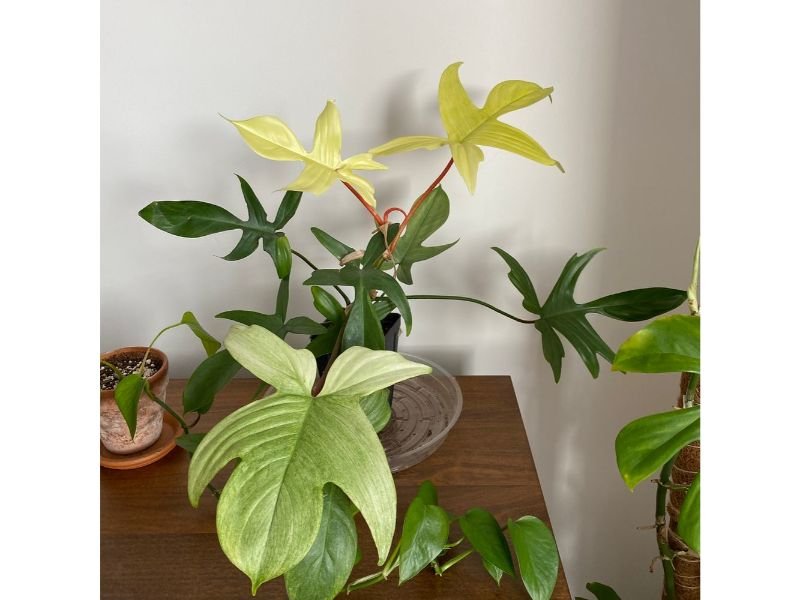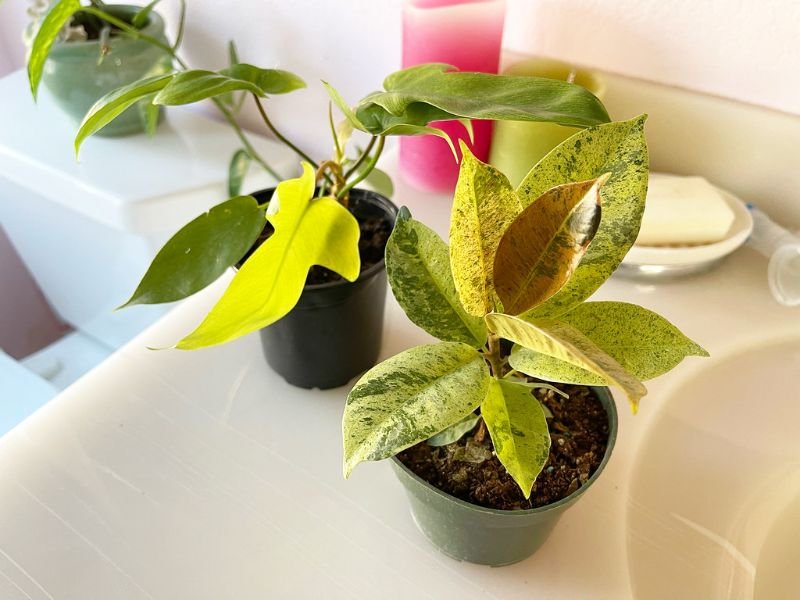Philodendron Florida Ghost is one of the most notable tropical foliage houseplants, favored for their striking and shiny foliage shape. Although being naturally easy to take care of, just as much as any other philodendron relatives, maintaining Philodendron Florida Ghost could be tricky if you are not sure how to. It’s best to keep this care guide and tips in mind before bringing home the Ghost Florida Plant. After all, a happy and healthy plant is all we’re aiming for. So without further ado, let’s get started!
Table of Contents
What Is a Philodendron Florida Ghost?

Philodendron Florida Ghost is a cultivated species of Philodendron, a foliage tropical plant famous for being easy-maintenance houseplants and decorative plants. The name Philodendron is derived from the Greek words ‘philo’, which means love, and ‘dendron’, which means tree. Although most Philodendron species are cultivated because of their heart-shaped foliage, Philodendron Florida Ghost is an exception.
This exotic beauty has foliage that is shaped like a flying ghost–bizarrely resembling a ghost emoji! The young foliage of Philodendron Florida Ghost is creamy white-colored, and as the plant matures, it will turn dark green. To prevent the cultivated Philodendron species from reverting to their natural color, place them under bright, indirect sunlight where they thrive the most.
Is the Philodendron Florida Ghost poisonous?
Yes, they share the same aspect as their Philodendron relatives, so all part of the Ghost Florida Plant is toxic to both humans and pets. They contain harmful chemical components such as oxalic acid and calcium oxalates that can be fatal if ingested in large quantities. Keep the plant away from children, pets, and older people.
Philodendron Florida Ghost Basic Overview

Growing Zones: Best in 8 to 11
Blooming Time: Spring to summer
Life Cycle: Perennial
Size: 60 to 150 centimeters
Flower: Rare, seldom flowering, no fragrance
Fruit: No
Best For: Both indoor and outdoor gardens
Philodendron Florida Ghost Care: Tips and Trick
Now that you acknowledge all the basic information, it’s time to dive into the main topic. Maintaining the delicate Philodendron Florida Ghost should not give you a headache. The paramount key is to provide the tropical beauty with the right amount of light, soil, and watering requirements–and you’re all set.
Sunlight and Temperature Requirements

As an endemic plant to the humid and warm tropical rainforests, Philodendron Florida Ghost is best kept in an area with bright but indirect sunlight to mimic their natural habitat. Too much exposure to direct sunlight can do more harm than good, as it will burn their foliage.
Like most tropical plants, Philodendron Florida Ghost can tolerate a minimum temperature of anywhere from 18 to 29-degree Celsius.
Tips: The plant is not cold tolerant and may go dormant during winter or if placed in an area with colder temperatures, but keeping the soil moist is still a must. Water your Philodendron Florida Ghost at least once a week during the cold season.
Soil Requirements

The next crucial Philodendron Florida Ghost care you should keep an eye on is the soil requirements. Many species of the Araceae Family love slightly acidic soil, with a pH of 5.0 to 6.0, and the Ghost Florida plant is no exception. Additionally, well-drained soil with good aeration is also the plant’s favorite.
Tips: Mixing orchid barks, manure, perlite, and coco coir into your potting soil will help you achieve the goal of well-drained and well-aerated soil. Plus, natural components like coco coir are rich in cellulose, lignin, and pectin–all the good ingredients for the Florida Ghost plant’s growth.
How Often Should You Water the Philodendron Florida Ghost?
The rule of thumb when it comes to watering your Philodendron Florida Ghost is to always keep the soil moist but not soaked. The best way to achieve this is by doing regular watering about once a week or once every two weeks. Do not let the soil completely dry out. This watering rule also applies during the plant’s growing season, which occurs during spring and summer.
Tips: Utilize the help from plant spray mist to spray the Florida Ghost plant’s foliage–to add extra moisture without having the plant overwatered. Look for the best-growing containers with drainage holes to prevent unwanted excess water from remaining in the soil–which can cause root rot.
What Are the Best Fertilizers For Philodendron Florida Ghost?
Fertilize the Philodendron Florida Ghost with the basic nitrogen, phosphorus, and potassium with a 20-20-20 ratio or a balanced ratio. Fertilizing should be done once a month during the growing season.
Tips: Organic fertilizers such as chicken or cattle manure and citrus fruit peels can be safely used as alternatives for NPK fertilizers. They provide the same nutrients and cost less!
Does the Ghost Florida Plant Go Dormant During Winter?
Yes, as stated before, the Philodendron Florida Ghost is not cold tolerant and anything below 18 celsius is too cold for the plant. To wake the Florida Ghost plant up, bring them back to humid areas with bright, indirect sunlight. Keep the regular watering schedule but do it less often. Do not fertilize during the dormant phase.
Does the Philodendron Florida Ghost Prefer a Humid Area?
Whether kept as an indoor or outdoor plant, the Philodendron Florida Ghost thrives well in humid areas. Keep the humidity level about 50-90% to imitate their native habitat’s humidity.
Tips: For those who live in dry areas, there are ways to increase humidity. First, you can move the Philodendron Florida Ghost plant to more humid areas of your home. Spray the foliage with a water mist to prevent the humidity from escaping. If you want to get more dedicated, buy a humidifier and place it where the Florida Ghost plant thrives.
How Do You Do Pruning and Repotting?
Like any other plant, the Philodendron Florida Ghost plant needs regular pruning and repotting to make them stay healthy. To prune the Ghost Florida plant, start by cutting any dead and diseased foliage and stems using sterile gardening shears and scissors. Pruning should also be done once the plant gets too long because of its rapid growth.
Tips: Do not excessively prune the Philodendron Florida Ghost plant and cut back no more than 30% portion of the plant.
The best time to repot a Philodendron Florida Ghost plant is before its growing season, as new growth will spurt, and repotting will do wonders to prevent the roots from bounding. You’ll need bigger containers or pots for this step.
Tips: Aside from choosing the best-growing medium with drainage holes, take note of the material. The most common materials are terra-cotta (or clay) and plastic. Clay might be heavier and more prone to damage from cracks, but over time, plastic containers degrade and have a higher risk level of bisphenol A.
Philodendron Florida Ghost Common Pests and Diseases
As with any other plant, the Philodendron Florida Ghost is also prone to pests and diseases. Here are the most common ones and how to manage them.
Mealybugs
These tiny, oval-shaped insects are covered in white and are one of the most common pests of many houseplants. They feed on the plant’s juice or sap and inhabit moist, warm areas. To manage mealybugs, you can use imidacloprid pesticide in moderation.
Aphids
Other pests that like to feed on the Philodendron Florida Ghost’s sap and roots are aphids. To manage aphids from further hurting your plant, spray the plant carefully using insecticidal soap or horticultural oil.
Leaf spots, yellowing or browning leaves
Often caused by overwatering or Xanthomonas bacteria. To manage, avoid overwatering, and make sure to get a Philodendron Florida Ghost that is free from bacteria.
Curling tips
Caused by over-fertilizing. Most of cases the root will rot and then die. To manage, decrease the use of fertilizer (both chemical and organic) and repot the plant completely if you use the slow-release fertilizer type.
Powdery mildew
White, ‘powdery’-look patches on foliage caused by Oidium spp fungi. Carefully wipe or prune any infected area after symptoms occur. Isolate the infected Philodendron Florida Ghost from any other plant as this disease is highly contagious. To manage, use a commercially available fungicide, neem oil, potassium bicarbonate, sulfur, and insecticidal soap.
Florida Ghost Care In a Summary
To conclude, the Philodendron Florida Ghost requires to be placed in humid and warm areas with bright but indirect light, regular watering to keep the soil moist, moderate fertilizer and growing media such as perlites and coco coir to provide more aeration and drainage. Common pests and diseases such as mealybugs and yellowing leaves can be simply cured using commercially available pesticides and decreasing the water intake. We hope this Philodendron Florida Ghost care and tips give you some sort of insight. Happy Gardening!

New author in the hood. Loves gardening and flowers are my spirit animals (yes I know they are not animals but I insist). I will be covering most of the flowers’ topics here and occasionally random though as well.






